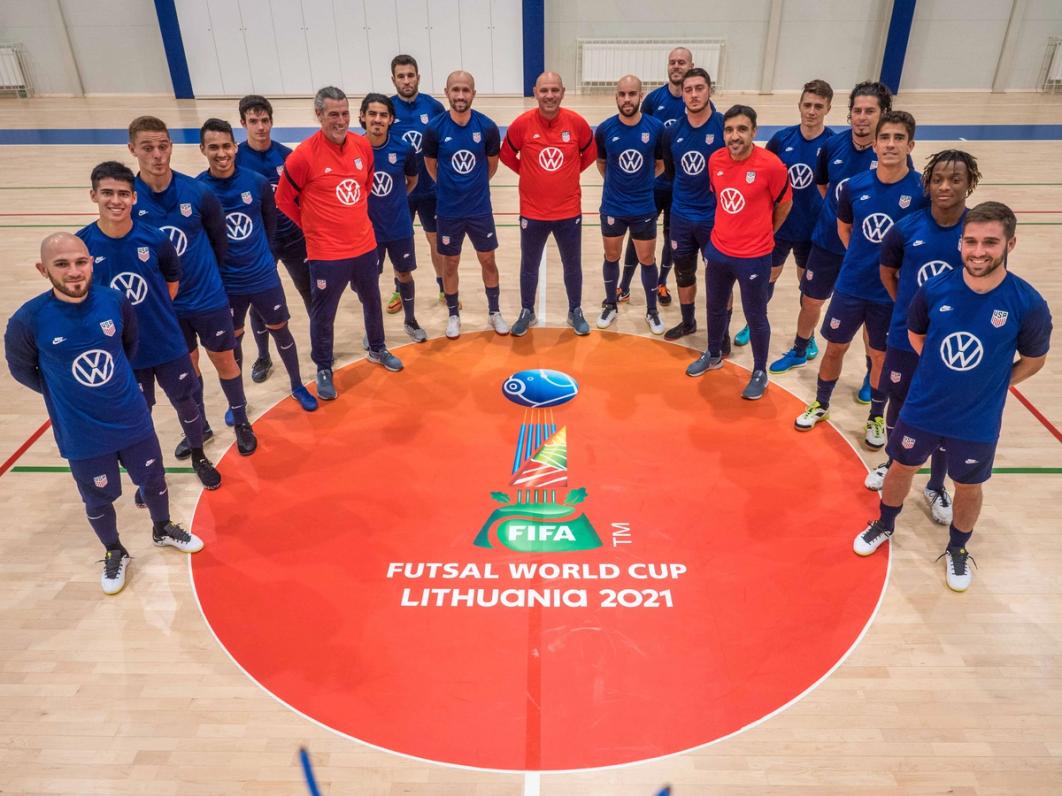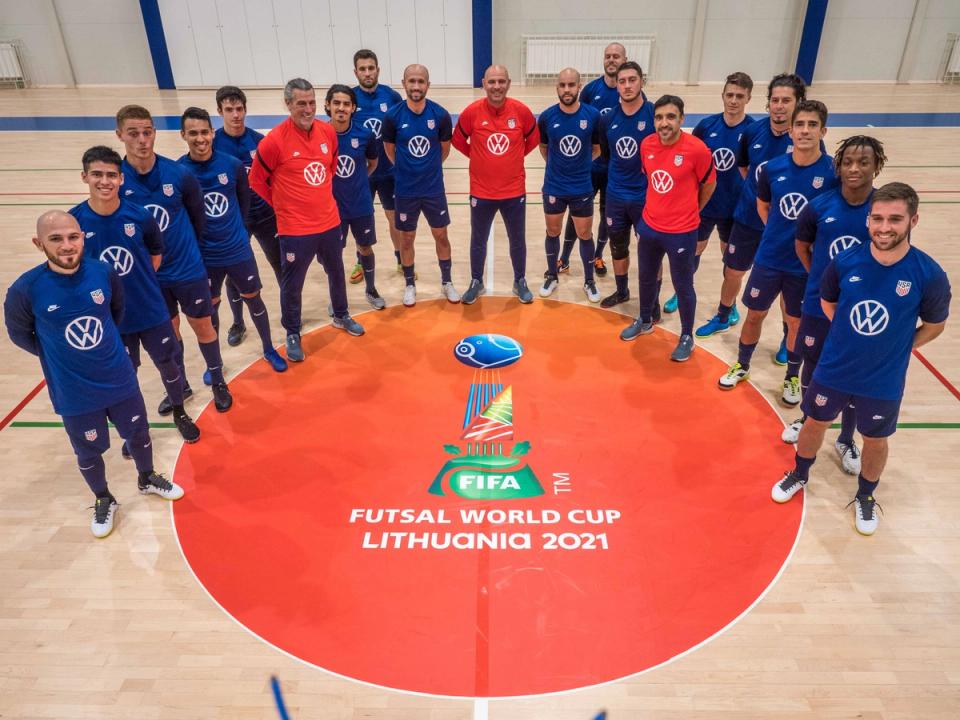Five Things to Know About the 2021 FIFA Futsal World Cup
U.S. Futsal National Team Returns to World Cup for First Time Since 2008; USA Will Face Argentina, Iran and Serbia in Group F



The U.S. Futsal National Team is competing at the FIFA Futsal World Cup for the first time since 2008. After the tournament was postponed from fall 2020 due to the global COVID-19 pandemic, the competition is set to run Sept. 12 to Oct. 3 in three cities across the eastern European nation.
First, a quick primer: futsal is a sport derived from soccer and played with four field players and a goalkeeper on a basketball-style court, with no walls and a smaller, low-bouncing ball. Rewarding high technical ability and quick decisions in tight spaces, games consist of two 20-minute halves, with the clock stopping when the ball goes out of play and on fouls. At the World Cup, FIFA will also utilize Video Service (VS) for the first time, where coaches may challenge select referee decisions for video review.
The first FIFA Futsal World Cup was held in January 1989 in the Netherlands with 16 invited teams. Brazil defeated the Netherlands to win the title and the USA beat Belgium for the bronze medal. The next tournament was held in 1992, where the USA finished second to Brazil.
Since then, the World Cup has been played every four years with each confederation holding a qualifying tournament. The World Cup field increased to 20 teams in 2008 and to 24 teams in 2012. Brazil has reached the podium in seven of the first eight World Cups, winning five. Spain is next with two titles and six finishes in the top three. In 2016, Argentina became just the third country to win the Futsal World Cup:
Year (location): Winner, Second Place, Third place:
1989 (Netherlands): Brazil, Netherlands, USA
1992 (Hong Kong): Brazil, USA, Spain
1996 (Spain): Brazil, Spain, Russia
2000 (Guatemala): Spain, Brazil, Portugal
2004 (Taiwan): Spain, Italy, Brazil
2008 (Brazil): Brazil, Spain, Italy
2012 (Thailand): Brazil, Spain, Italy
2016 (Colombia): Argentina, Russia, Iran
The U.S. is competing in its sixth FIFA Futsal World Cup and first since 2008. The team did not qualify in 2000, 2012 and 2016.
1989: The USA’s first Futsal World Cup team included future outdoor World Cup players Tab Ramos, Steve Trittschuh, Peter Vermes, David Vanole, Michael Windishmann, Eric Eichmann and Bruce Murray, among other talented indoor and outdoor players. After drawing with Australia to open the tournament, the USA defeated Zimbabwe, Italy, Argentina, Paraguay and Brazil before falling to the Netherlands in the semifinal. The U.S. beat Belgium 3-2 in the third-place match to take home the bronze medal.
1992: Behind stars from the U.S. indoor leagues like goalkeeper Victor Nogueira, Ted Eck, Jim Gabarra and Dale Ervine, plus future World Cup players Jeff Agoos and Fernando Clavijo, the USA defeated Russia, China and Argentina, tied Brazil and the Netherlands, and beat Iran in the semifinals before falling to Brazil in the final. The second-place finish is the highest for a male U.S. National Team at a FIFA competition.
1996: Nogueira, Frank Klopas, Dennis Brose, Franklin McIntosh and company played two competitive matches early, but dropped each with a 1-0 loss to Uruguay and 4-2 to Italy. Though the team did not advance to the knockout round, it finished group play with a 10-2 win over Malaysia, still a team record for goals and margin of victory at a World Cup.
2004: Former MLS players Johnny Torres, John Ball, Sean Bowers and Jamar Beasley formed part of the core of the team that would advance out of the initial group stage with a win against Paraguay and tie with Japan. In the knockout group stage, the team battled but lost all three matches: 2-1 to Argentina, 3-1 to Ukraine and 8-5 to Brazil.
2008: Beasley and Pat Morris were the lone holdovers from the 2004 World Cup and were joined by future MLS player Andrew Jacobson. The tournament was a disappointment for the U.S. as the team lost all three group matches to Paraguay, Italy and Thailand.
The 2021 FIFA Futsal World Cup field is made up of 24 teams for a third consecutive tournament, divided into six groups of four. The top two teams in each group after round robin play will advance to the Round of 16, as will the four best third-place teams. The knockout stage is single elimination, with overtime and penalty kicks if needed. The groups are as follows:
Group A: Lithuania, Venezuela, Kazakhstan, Costa Rica
Group B: Russia (Football Union), Egypt, Uzbekistan, Guatemala
Group C: Portugal, Morocco, Solomon Islands, Thailand
Group D: Brazil, Czech Republic, Panama, Vietnam
Group E: Spain, Japan, Angola, Paraguay
Group F: Argentina, USA, Serbia, Iran
Tuesday, Sept. 14 vs Argentina | Vilnius Arena in Vilnius, Lithuania
8 p.m. local, 1 p.m. ET; FS2, NBC Universo, TelemundoDeportes.com, Fox Sports App
Argentina arrives at the World Cup as defending champion and winner of CONMEBOL Futsal World Cup qualifying by beating rival Brazil in the final. Argentina joins Brazil and Spain as the only countries to participate in all nine World Cups. Matías Lucuix was an assistant coach in 2016 and is now at the helm for Argentina. He brings with him 11 players from the 2016 championship team, including Cristian Borruto, who is competing in his fourth World Cup, Damián Stazzone, who will be playing in his third and goalkeeper Nicolas Sarmiento, who was named the tournament’s best ‘keeper in 2016. At the Futsal World Cup, the USA defeated Argentina 3-1 in 1989 and 6-2 in 1992, but lost 2-1 in the knockout group stage in 2004.
Friday, Sept. 17 vs Iran | Vilnius Arena in Vilnius, Lithuania
6 p.m. local, 11 a.m. ET; FS2, TelemundoDeportes.com, Fox Sports App
Iran is competing in its eighth straight Futsal World Cup, more than any other Asian nation. This year, Iran was nominated to participate by the Asian Football Confederation after the original qualifying tournament was canceled. Iran has dominated in regional competition, winning the AFC Futsal Championship trophy 12 times before. Iran made history by finishing third at the 2016 World Cup, the best-ever result by an Asian team. Much of that squad returns in 2021, including Mahdi Javid, Hossein Tayebi and captain Ali Asghar Hassanzadeh, four-time AFC Futsal Player of the Year. The U.S. topped Iran in their only meeting, winning the semifinals of the 1992 FIFA Futsal World Cup 4-2 behind a hat trick from Dale Ervine and another from Ted Eck.
Monday, Sept. 20 vs Serbia | Klaipeda Arena in Klaipeda, Lithuania
8 p.m. local, 1 p.m. ET; FS2, TelemundoDeportes.com; Fox Sports App
Serbia clinched one of the final two berths from Europe in a tightly contested playoff vs. Finland after winning five of six games in the main qualifying competition. They are participating in their second Futsal World Cup (2012). The USA and Serbia have never faced off at this tournament, but have several connections. U.S. head coach Dusan Jakica is born in Novi Sad, Serbia. He was a pro futsal player and then coach in Serbia, including as an assistant with Serbia’s National Team before moving to the U.S. in 2015. Serbian players Davor Popovic and Dragan Tomic are former students of Jakica’s. Dusan was Popovic’s robotics teacher at a vocational school for mechanical engineering and coached him when he was 15-years old. Tomic and Popovic were on Jakica’s university National Team at the 2014 European Championships.
Led by head coach Dusan Jakica, the U.S. roster is led by captain and veteran goalkeeper Diego Moretti, who has played futsal professionally in Italy for the last 17 years. Luciano Gonzalez (Italy) and Tomas Pondeca (France) also play futsal in Europe. Gonzalez led the USA with five combined goals and assists at the Concacaf Futsal Championship in May in Guatemala, while the 19-year-old Pondeca, who leads the team with six goals during the cycle, claimed Young Player of the Tournament honors.
In all, 12 players on the roster helped the USA qualify for the 2021 Futsal World Cup in May in Guatemala- including all eight goal-scorers. Ala Daniel Mattos is the only player to return from from the 2016 cycle and seven play professionally on pro indoor clubs in the MASL
GOALKEEPERS (3): 1-Diego Moretti (Ancona, Italy; Unattached), 11-Robert Damron (Northville, Mich.; Michigan Futsal Factory), 12-Estevan Vazquez (Fort Worth, Texas; Mesquite Outlaws)
ALAS (7): 3-Jeremy Klepal (Lansing, Mich.; Lansing City FC), 6-Luciano Gonzalez (Mendoza, Argentina; Citta di Massa C5/ITA), 8-Daniel Mattos (Chicago, Ill.; Milwaukee Wave), 9-David Ortiz (Dallas, Texas; Dallas Sidekicks), 10-Tomas Pondeca (Dallas, Texas; Paris Acasa/FRA), 14-Diego Bobadilla-Mireles (Holland, Mich.; St. Louis Ambush), 16-Alencar Ventura-Junior (Tewksbury, Mass.; Safira Futsal)
FIXOS (3): 4-Eduardo Buenfil (San Jose, Calif.; Unattached), 5-Julian Escobar (Hicksville, NY; Harrisburg Heat), 15-Guilherme Veiga (Milwaukee, Wisc.; Milwaukee Wave)
PIVOS (3): 2-Raphael Araujo (Bound Brook, N.J.; NY Ecuador FC), 7-Everson Maciel (Milford, Conn.; Safira Futsal), 13-Zach Reget (Kenosha, Wisc.; Florida Tropics)
Head Coach: Dusan Jakica
Assistant Coaches: Pablo Da Silva, Otto Orf
Performance Coach: Daniel Wartner
MORE STORIES:
DUSAN JAKICA: ENGINEERING HIS PATH TO THE FIFA FUTAL WORLD CUP
USA QUALIFIES FOR FUTSAL WORLD CUP FOR FIRST TIME SINCE 2008